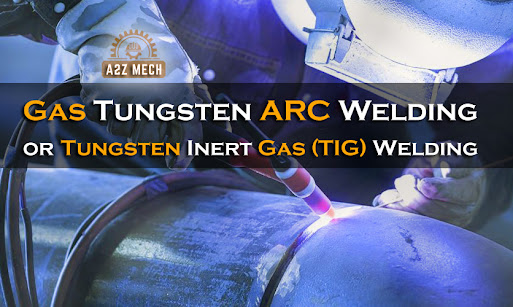Gas Tungsten Arc Welding Or TIG Welding
Gas Tungsten Arc Welding (GTAW) is a type of welding process that uses a non-consumable tungsten electrode to produce the weld. The process involves heating the work piece and the filler material (if used) to a very high temperature with an electric arc created between the tungsten electrode and the work piece.
It is also known as Tungsten Inert Gas (TIG) welding.
|
Contents 1.2
Advantages of TIG welding. |
During TIG
welding, a shielding gas is typically used to protect the weld from atmospheric
contamination. The most common shielding gases used in TIG welding are argon
and helium.
TIG welding is
commonly used for welding thin materials such as stainless steel, aluminium,
and copper alloys. It is also used for welding exotic metals like titanium and
molybdenum.
1.1 The TIG Welding Process.
TIG welding involves
several steps in order to produce a high-quality weld. Here is a general
overview of the TIG welding process:
Ø Preparation: The first step is to prepare the work
piece for welding. This includes cleaning and prepping the metal, cutting and
fitting the pieces, and securing them in place.
Ø Power source: The TIG welding machine must be set up
properly, including connecting the power source, gas supply, and welding torch.
Ø Electrode selection: The tungsten electrode used in TIG welding
must be selected based on the type of metal being welded, the thickness of the
metal, and the welding amperage.
Ø Gas selection: The shielding gas used in TIG welding is
typically argon or helium. The gas flow rate must be set properly for the job.
Ø Welding technique: The TIG welding torch is held at a specific angle and
distance from the work piece, and the electrode is carefully fed into the arc
to melt the metal and create the weld. The filler rod, if used, is also
carefully added to the molten puddle.
Ø Post-welding: Once the welding is complete, the weld is
typically cleaned and inspected to ensure it meets the required quality
standards.
TIG welding
requires a high level of skill and precision, and can be challenging to master.
However, it is an excellent choice for producing high-quality welds in a
variety of metals and applications.
GTAW, or TIG
welding, has several advantages and disadvantages, as well as various
applications. Here are some of the pros, cons, and applications of GTAW
welding:
1.2 ADVANTAGES:
v
Provides
a high-quality weld with excellent precision, control, and cleanliness.
v
Can
weld a wide variety of metals, including stainless steel, aluminium, and copper
alloys.
v
Allows
for welding thin materials without distortion or warping.
v
Does
not produce spatter or smoke, which can be a safety hazard and cause damage to
surrounding areas.
v
Produces
a very clean and aesthetically pleasing weld.
1.3 Disadvantages of TIG Welding.
v
Can be
a slower welding process compared to other methods, leading to increased
production time and costs.
v
Requires
a higher level of skill and expertise to perform correctly.
v
Tungsten
electrodes require frequent sharpening or replacement, adding to the overall
cost of the process.
v
The
welding torch and shielding gas equipment can be bulky and difficult to manoeuvre
in certain situations.
1.4
Applications of TIG Welding.
v
GTAW
is commonly used in aerospace, aviation, and automotive industries for welding aluminium
and other lightweight metals.
v
It is
also used in the fabrication of medical equipment, food processing machinery,
and other precision manufacturing applications.
v
GTAW
is particularly useful for welding pipes, tubing, and other components that
require precise, high-quality welds.
v
It is
often used for artistic applications, such as welding sculptures, metal
furniture, and jewellery.
Overall, GTAW
welding is a versatile and effective welding method that can produce
high-quality welds in a variety of applications. While it can be more
challenging and time-consuming than other methods, its precision and
cleanliness make it an excellent choice for certain welding projects.




No comments